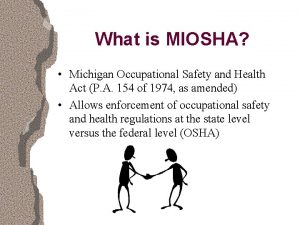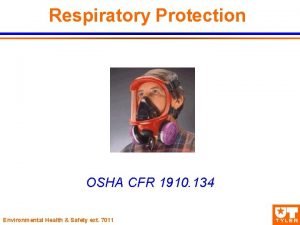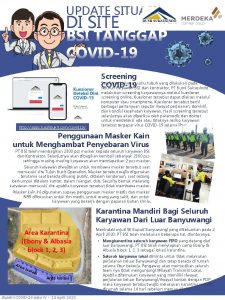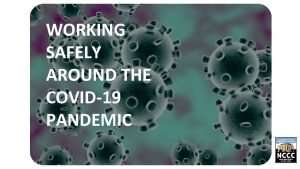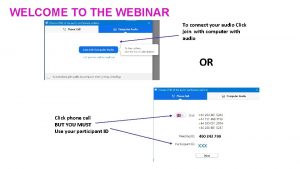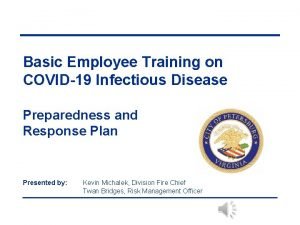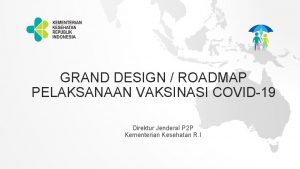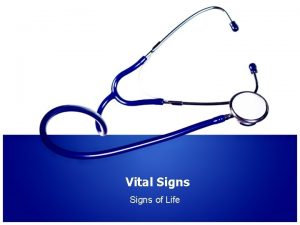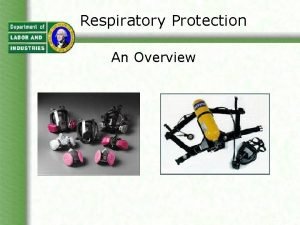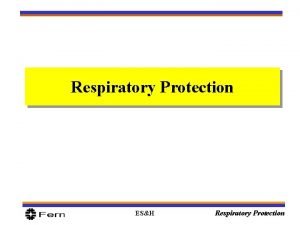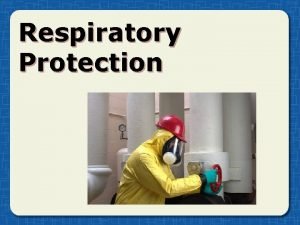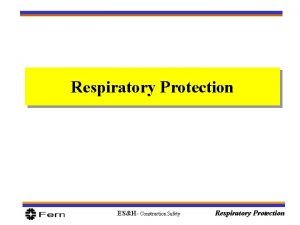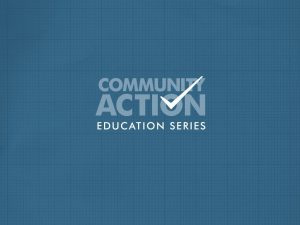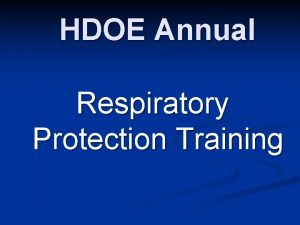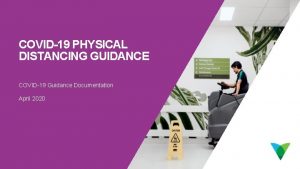COVID19 USE OF RESPIRATORY PROTECTION GUIDANCE COVID19 Guidance











- Slides: 11

COVID-19 USE OF RESPIRATORY PROTECTION GUIDANCE COVID-19 Guidance Documentation March 2020 1 COVID-19 Use of Respiratory Protection Guidance

NOTICE The information in this pack is consistent with advice from World Health Organization, Australian Government Department of Health, Ministry of Health New Zealand US Centre for Disease Control, and requirements of Australian and State Governments, as at 25 March 2020. However, Government advice and regulations regarding COVID-19 are changing often, sometimes within the course of a day. If advice from these agencies in relation to this issue changes, or a relevant Government mandates further action in relation to the issues dealt with in this pack, Ventia will update the content to reflect that changed advice and/or mandated action. Please continue to refer to the. Vine to ensure you have the most up to date information packs 2 COVID-19 Use of Respiratory Protection Guidance

DISCLAIMER The following material has been developed by Ventia, one of Tf. NSW’s major contractors to support Ventia leaders in managing COVID-19 risks in their workplaces. The material has been developed taking account of advice from World Health Organization, Australian Government Department of Health, US Centre for Disease Control, and requirements of Australian and State Governments at the date noted in the packs. Ventia has agreed to make the material available to Tf. NSW to inform and assist Tf. NSW in relation to the management of COVID-19 risks. Please note, however, that it has been developed to support Ventia’s specific context and may not be relevant to other organisations or in all Tf. NSW contexts. The reader will need to exercise judgement about the appropriateness of the Ventia materials and their relevance to the reader’s own requirements. Please note also that Government requirements regarding COVID-19 may continue to change, and the materials will need to be assessed against current government requirements. 3 COVID-19 Use of Respiratory Protection Guidance

COVID-19 USE OF RESPIRATORS The COVID-19 virus is spread mainly from person-to-person in close contact with one another, through respiratory droplets produced when an infected person coughs or sneezes or by touching a surface or object that has the virus on it and then touching the face. Practising physical distancing and good hand sneeze/cough hygiene is the best defence against viruses. Current health advice is that most people will not benefit from wearing a surgical mask or a respirator. Masks are of benefit to people who are sick so they don’t cough on others, and health care workers who have frequent, close contact with sick people. Even within clinical settings, P 2 respirators are maintained for specialised procedures likely to generate aerosol from suspected COVID-19 persons. 4 COVID-19 Use of Respiratory Protection Guidance

CIRCUMSTANCES WHERE WE MAY USE MASKS/RESPIRATORS However, in specialised circumstances there may be times where the use of P 2 respirators is implemented as appropriate protection. These circumstances must be based on risk assessment and should consider all relevant risk factors. • Existing works that require use of a P 2 respirators (such as asbestos works) • Sanitisation of workplaces or vehicles where a confirmed case of COVID-19 has been present (refer COVID-19 cleaning and disinfection guidance materials) • Where close contact with a confirmed or suspected case of COVID-19 may be necessary (such as certain examples of incident response) If stock start to become low for P 2 respirators, notify your supervisor or manager Reusable respiratory protection (such as full face respirators) with P 2 cartridges may be appropriate alternatives for tasks which will regularly need P 2 respiratory protection and stock may be more readily available at these times. 5 COVID-19 Use of Respiratory Protection Guidance

3 HOW TO WEAR A P 2 RESPIRATOR CORRECTLY 1. 2. 3. 4. 5. 6. 7. 8. 9. Wash your hands before putting on the mask Remove glasses and hats. Tie back long hair to avoid becoming tangled in the respirator straps Position the respirator in your hands with the nose piece at your fingertips Cup the respirator in your hand allowing the headbands to hang below your hand Hold the respirator under your chin with the nosepiece up While holding the respirator firmly in place on your face, pull the top strap over the head so it rests high on the back of your head Pull the bottom strap over your head and position around the neck and below the ears Ensure the straps remain untwisted and place your fingers at the top of the respirator and slide them down both sides of the respirator to mould the nose area to the shape of your nose Conduct a fit check (see next slide) 6 COVID-19 Use of Respiratory Protection Guidance 4 7 8

CONDUCTING A FIT CHECK FOR A P 2 RESPIRATOR A fit check should be conducted at every use 1 2 1. Place both hands over the respirator, take a quick breath in to check whether the respirator seals tightly to the face 2. Place both hands completely over the respirator and exhale. If you feel leakage, there is not a proper seal 3. If air leaks around the nose, readjust the nosepiece as described. If air leaks at the mask edges, readjust the straps along the sides of your head until a proper seal is achieved If the respirator still leaks you may need to try a different size or style of respirator. 7 COVID-19 Use of Respiratory Protection Guidance 3

HOW TO REMOVE A P 2 RESPIRATOR CORRECTLY 1. Remove bottom strap by pulling over head 2. Maintaining hold on the first strap, use another hand to pull the top strap over head 3. Avoid touching front surface of the respirator, continue to hold it by the straps 4. Discard the used respirator into a waste container 5. Wash hands 1 8 COVID-19 Use of Respiratory Protection Guidance 2 3

USERS MUST BE CLEAN SHAVEN People with beards should shave before using a P 2 respirator as a good seal between the respirator and the wearer’s face cannot be guaranteed if they have facial hair. Must be clean shaven where the respirators sits. People with even 1 -2 day beard growth may not be able to achieve an adequate seal between the respirator and the wearer’s face. 9 COVID-19 Use of Respiratory Protection Guidance

RESPIRATOR FIT TESTING Fit testing is performed before use to ensure: • Respirator fits correctly and provides adequate protection • Verifies that the respirator provides the user an adequate seal There are two methods of fit testing that may be used: • Qualitative fit testing - uses a hood an odour or taste solution to determine the ability of the respirator wearer to smell or taste the test agent. • Quantitative fit testing – uses specialised equipment to measure how much air leaks into the respirator. Fit-testing can be carried out by: • a competent person (such as an occupational hygienist) • manufacturer, supplier or service provider for respirators 10 COVID-19 Use of Respiratory Protection Guidance

KEY TAKEAWAYS • Use of respiratory protection is a mitigation that should be implemented only under specific circumstances to manage COVID 19 • Respirator use is to be risk assessed and rationalised – maintaining stocks of respirators to workers who need to use them • Refer to the manufacturer’s instructions for specific advice on fitting and checking the fit of the individual brands of respirators • For a respirator to function correctly – users must be clean shaven 11 COVID-19 Use of Respiratory Protection Guidance
 Respiratory zone vs conducting zone
Respiratory zone vs conducting zone Michigan occupational safety and health act
Michigan occupational safety and health act Osha 1910 respiratory protection
Osha 1910 respiratory protection Http://apps.tujuhbukit.com/covid19/
Http://apps.tujuhbukit.com/covid19/ Do if you covid19
Do if you covid19 Covid19 athome rapid what know
Covid19 athome rapid what know What do if test positive covid19
What do if test positive covid19 Vaksin covid19
Vaksin covid19 Semianatomic
Semianatomic What is the purpose of direct and indirect guidance
What is the purpose of direct and indirect guidance How you use ict today and how you will use it tomorrow
How you use ict today and how you will use it tomorrow Main vital signs
Main vital signs

